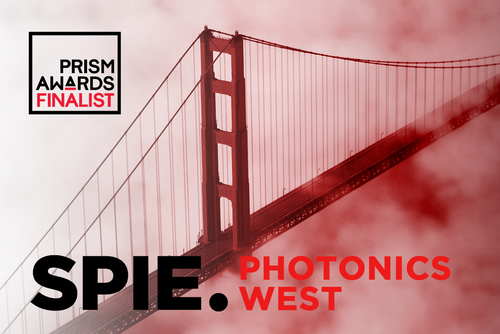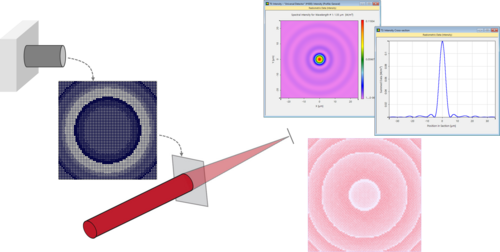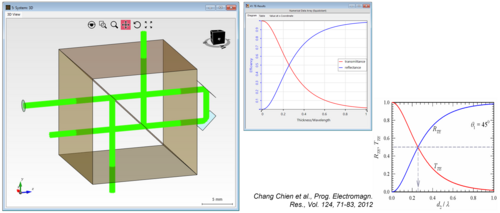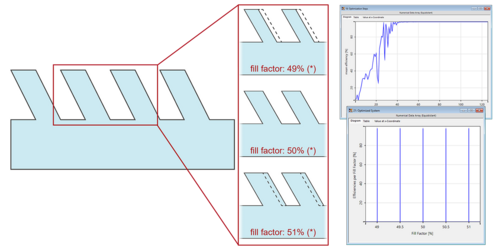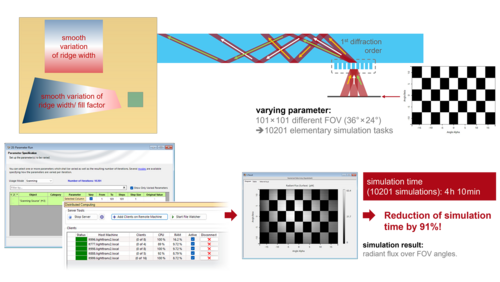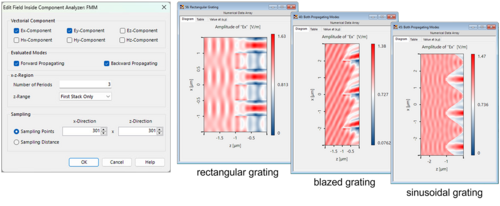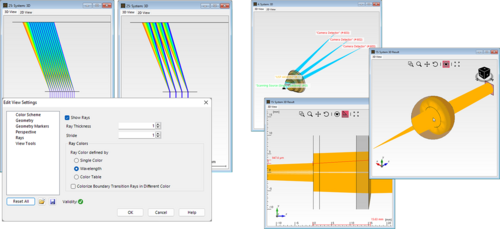What’s new in our Optical Modeling and Design Software?
Back to the future of DOE design
Over the next two months we return to our roots and focus on diffractive optical elements (DOEs), but without forgetting how far we have come: We put DOE modelling and design in the context of modern VirtualLab Fusion technology.
In the upcoming webinar we showcase the design and analysis of diffractive optical elements acting as a diffuser and a beam splitter respectively. To that end, we employ the iterative Fourier transform algorithm (IFTA) optimization and, afterwards, study the performance of the resulting designs in a system, using VirtualLab Fusion’s interoperability of modeling techniques.
If you are a complete beginner, or if you would like to deepen or refresh your knowledge of VirtualLab Fusion, we suggest you join our Getting Started Online Training. This course, takes place directly before our topic-specific Online Training "Design & Analysis of Diffractive Beam Splitter & Light Diffuser", where we go into detail about the basic configuration and handling of our IFTA optimization and embed this process in two real-life applications. Both courses can of course be booked in combination, if you are interested in the whole package!
Take part in the courses and see for yourself!
SPIE Photonics West + AR|VR|MR
We have reason to celebrate ! Good things come in pairs: This same year in which we commemorate our 25th company anniversary, we are also proud to announce our renewed nomination for his edition of the PRISM Award. Celebrate with us – join us at Photonics West!
Read moreDesign of Meta-Structures: One Year Closer to the Future
The New Year is always a time for reflection on the passing of time and, in this spirit, we have decided to inaugurate 2024 with a webinar on a topic which, not so long ago, sounded positively futuristic: optical meta-structures.
Capabilities in this area have improved by leaps and bounds in the last few years, both in terms of simulation and, crucially, fabrication of the sub-wavelength (i.e. nanometer-sized) structures required to produce the necessary response.
In this free webinar we present the technology of the optical simulation software VirtualLab Fusion to overcome the notable challenges involved in the analysis and design of optical meta-structures. And we do so along two different examples: a beam-splitter and a meta-lens.
Interested? Don’t hesitate to join!
Rigorous Simulation of Sub-Wavelength Structures in Optical Systems
The interoperability of modeling techniques implemented in the optical design software VirtualLab Fusion means that its users can navigate the ever-relevant compromise between accuracy and speed with full flexibility. That is also the case when it comes to simulating the propagation of light through sub-wavelength structures: rigorous models can be selected just for those parts of the optical system that exhibit sub-wavelength modulation, while choosing numerically lighter alternatives elsewhere in the system, thus reaching the required accuracy without sacrificing speed unnecessarily.
But don’t take our word for it – see for yourself!
You can find links below to two very different examples of systems with sub-wavelength structures: the illustration of the design workflow of a meta-lens constructed from an arrangement of nano-pillars with different diameters, and a prism beam splitter based on the working principle of frustrated total internal reflection (FTIR), where the energy redistribution between the two arms of the splitter is achieved by the evanescent waves tunneling through a thin layer of material barely separating two prisms of a denser medium.
Robustness Analysis and Optimization of Grating Setups
Gratings are a fundamental tool in the arsenal of many optical engineers, since their physical properties (of diffracting incident light into a set of discrete orders) make them a very attractive tool in many different configurations and for many different applications. It is then of major interest to investigate how well a given grating setup can tolerate small deviations from the design parameters, created by e.g. manufacturing processes. Please take a look at the documents below to find an example in which we optimized a slanted grating to be resistant against variations in its fill factor. We achieved this using the newly released Parameter Variation Analyzer to perform a tolerance analysis of the setup and calculate a merit function that averages the efficiency of the working order for different fill factors.
But the parameters of the grating itself are not the only thing which can influence performance in this kind of system: most periodic structures with small feature sizes are known to be strongly sensitive to the polarization state of incident light. As the second use case for this week, we have selected a scenario in which the polarization dependency of a binary grating is analyzed, and the structure is optimized to perform well under incident light with arbitrary polarization angles.
Game-Changing Acceleration of Your Simulation With Distributed Computing!
VirtualLab Fusion now comes with the revolutionary Distributed Computing technology that allows you to tremendously speed up your simulations. To demonstrate the power of this new technology we have prepared two examples which you can find in the documents linked below. In the first one, we investigate the performance of a waveguide device by performing a parameter sweep over 101 x 101 field-of-view angles, resulting in a total of 10201 elementary simulations. With Distributed Computing, these simulations can be performed in parallel on different machines in a network, leading, in our specific example, to a 91% reduction in calculation time.
As a second example we have prepared a coherence measurement using a white-light interferometer. There, multiple wavelengths as well as a shift in one of the interferometer arms lead to a total number of 2904 simulations. Through the application of Distributed Computing we can reduce the simulation time from almost one hour to barely 3 minutes.
These examples demonstrate the game-changing reductions in simulation times which can be achieved with the new Distributed Computing Package. Take a look at the examples linked below and see for yourself!
Field Inside Analyzer for 2D Gratings
With the latest release of the optical modeling and design software VirtualLab Fusion, version 2023.2, a number of new and helpful tools have been added. But the novelty does not stop there: we have also taken this chance to upgrade some of our previously existing features. In this week’s newsletter we put the spotlight on the Field Inside Component: FMM analyzer, a tool that allows the user visualize and investigate the field distribution inside micro- and nanostructures. The analyzer can now also analyze 2D-periodic structures.
Please take a look at the documents below to find an introduction to the Field Inside Component: FMM analyzer as well as an example where we investigate (and go on to optimize) the reflectivity of an anti-reflection moth-eye structure.
VirtualLab Fusion 2023.2 – Easier Use, Better Control in Data Visualization!
While the Distributed Computing Package and the Parameter Variation Analyzer certainly are the highlights of the latest release of the optical modeling and design software VirtualLab Fusion, 2023.2, we have also implemented a whole set of new features and improvements for our result and data visualization, allowing the user a clearer picture of what is going on in the optical system.
Hence, in this week’s newsletter we want to put the spotlight on two of these additions. Please take a look at the documents linked below to find a guide to our Ray-Results 3D System View, the perfect engine to provide a quick overview of how the system is set up and what the light propagation inside it looks like. With this latest release, we have added options to, for instance, filter out any rays that do not pass a specific aperture, as well as new ruler to easily measure distances in the view. The second document tells you all you need to know about how regions work in VirtualLab Fusion, including the multiple new tools to scale, rotate and shift regions.





